Fencing Masks
Usual prices for masks, this is with all leather in place and ready to wear.
In stainless steel: $550 -- Mild Steel $450
A visor model is $100 more. That is either mild or stainless steels. Request photos per e-mail.
Made in Wisconsin by Edwin "Giles" Gilbert to designs created and sold by Terri Tindill as That Guy Products from 2007 to 2015. Terri is still making his beautiful gorgets (very protective), "Heidelberg" dueling glasses (a handsome joke-I trust), and other fencing accessories.
Mr. Tindill's mask design are among the absolute best available worldwide for fencers playing hard with swords heavier than foils and rapiers. These masks allow greater freedom of motion, comfort, and more protection than the mass produced wire weave masks you are familiar with.
They are popular with fencing clubs such as Historical European Martial Arts (HEMA) and Society for Creative Anachronism. I have added a chin strap upon recommendations of some physicians and instructors who practice with heavy swords and have examined the findings of the NFL (USA football) concerning concussions.

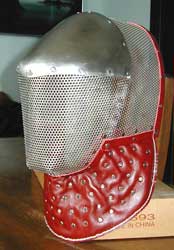
Mask Shells = the steel
We make the masks from 18 ga. steel. The perforations are .125" (1/8") in a staggered pattern with a 3/16" offset which leaves 40% of the surface open. The pieces are hand riveted together using 1/8" steel rivets (that ought to satisfy the geekier of you). Usually the forehead plate is solid 18ga.
The masks have a perforated (perf) steel face with two different chin designs (pointed or squared) and two different brow designs (half and quarter). These all are adapted to your head. I also offer a mask made entirely of perforated steel. It is based on the half brow plate design.
The chin variations are pointed and square. The difference is purely stylistic. I haven't noticed any structural advantage to one or the other.
There are differences with the brow plates. The half plate adds a bit more rigidity to the mask but also decreases the field of vision at upper corners of mask. The quarter plate adds a bit of vision and is not quite as ridged.
I recommend the half plate for a very upright German style of long sword, and the quarter plate for Italian rapier especially Fiore. Having trouble visualizing? Trigonometry. Half circle is one fourth of a sphere. Quarter circle is one eighth of a sphere. The circle I reference is the edge of the plate at the brow. The quarter circle is triangular shaped.
Here are the options and prices, for the bare steel:
I write this out to encourage customers to use their skills in sewing or leatherwork to finish their masks. Pounding iron is what I prefer doing, if you do the leather or cloth parts I can get back to more pounding. E-mail conversation welcomed.
Stainless steel is 304 and uses stainless steel rivets = $230 front and $90 back.
+ can add:
stainless steel quarter circle fore head of 18 ga perforated plate $30
stainless steel quarter circle fore head of 16 ga perforated plate $50. Perf plate is hardened in the perforation process. Forming 18ga into a half circle fore head or 16ga into a face requires tempering - do not have the ovens needed to temper stainless steel.
Mild steel is low carbon rolled plate = $170 front and $70 back + can add:
painted most any color for $30
mild steel fore head of 16ga solid steel $20
mild steel fore head of 16ga perforated plate $40
Mild steel's structural strength is nominally less than stainless steel, not enough to be noticed while in use. Many folk worry about rust with mild steel. This is real, stuff a mild mask in a bag with a sweaty jacket and it will rust. The first one I made in 1998 it is mild steel, painted, and still being used. I refurbished it in 2020. A few dents hammered out, rust brushed off. The leather was still functional - but I replaced it.
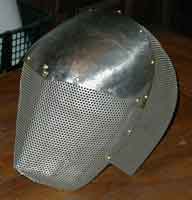
Trim and Bib
Leather trim and brigandine bib can be added for an additional $100.00.
Leather edging and bib are 2-3 ounce chrome tanned leather. Bib consists of two layers of 2-3 oz. chrome tanned leather with 20 ga. stainless steel fender washers riveted between. These colors of leather are available on a regular basis:
- Black
- Dark Blue
- Dark Green
- Medium Brown
- Dark Brown
Other colors may be available, email me for my current on hand supply.
Edging is a strip of leather folded over and riveted to the back edge of the mask. This edge of the perf plate is rolled to strengthen and give a smooth finished edge.

Suspensions
Suspensions are the leather straps holding the mask on to the head. Since they will get soaked with your sweat, they are made of vegetable/oak tanned leather. This is for two reasons: 1) To avoid the irritation some people's skin get from the chrome tanning chemicals; 2) Allow the leather to "wet form". When wet, the leather will tend to change shape and it becomes form-fitted to your skull. Suspensions are fastened to the mask with screw rivets (Chicago rivets). These allow you to adjust the suspension in pretty much any dimension. I suggest you lock these closed with "lock tite" or similar glue. Or pack a few spares in your mask bag as they will eventually unscrew themselves, probably in the bag.
Basic: A standard suspension is $35.00
The basic suspension system consists of an adjustable inverted "T" strap across the brow and up to top of head. There it meets a strap going down the back that has a slit for the strap around back of head (about brow height) and a ring just below occipital that guides the lower back of the head strap this lower strap pulls down to keep mask from rocking forward. I play a rather sedate fight. Do not partake of tourneys so this is quite sufficient. If you are a bit more wild some padding glued to the perf plate, or lightly to heavily padded coif, or rugby cap could be added for good protection.
If you are a long sword tourney competitor give thought to...
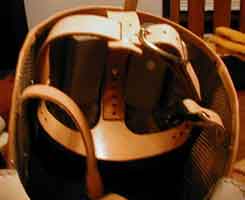
Basic suspension
Elaborate: A more enclosing suspension is $70.00
Is the basic suspension then adds 4 wide straps riveted to the front, back, and sides of the mask and then tied together at the top of the skull. This tie is adjustable. It holds the mask away from the skull. These straps are 4-5 ounce milled leather – vegetable-tanned. The layout is approximately what modern military and heavy hard hats use. My history books show that it has been used for about as long as helms.
Terry wrote a couple pages to help you adjust the elaborate suspension: Adjusting the Upgrade Mask Suspension
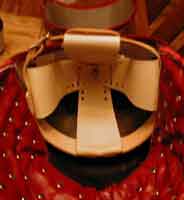
Elaborate suspension
Protection for the back of the head
A back plate is available in 18ga perforated plate in mild steel or stainless steel.
Most fencers do not need one. If you practice a style that needs one - you know it. Usually two handed-sword, cut & thrust, and other free flowing combats.
Steel perforated plate shaped to the skull. It is fastened to the top of the back of the mask with a cotter pin in a 16ga hinge. There are metal stops on the lower front corners of the back plate resting against the front of the mask. Straps run from back plate under chin of mask; to keep it in place as you move. The nape of the neck is draped with brigandine of leather and washers matching the bib.
Mild steel back of head: $70
Stainless steel head back: $90
Drape for back of neck (nape): $35
Back plates may be ordered as a stand-alone item. Be aware that adding the back plate will require some metal work on the mask. Two holes drilled. Rivets installed, screw rivets or hand hammered rivets. This could be done with a leather hinge.
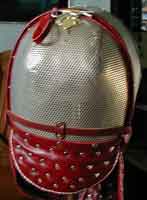
Hinge and Cotter Pin
Ordering a Mask (answer all 8 questions)
- Style (pointed or square chin)
- Brow plate style (half circle or quarter circle)
- Leather color for bib and trim
- Rivet color (silver, gun metal, brass - sometimes copper and red available)
- Steel type (18ga mild steel or 18ga Stainless steel)
- Back of head (18ga mild steel, 18ga. stainless steel)
- The following four measurements: head height, height to brow, head width (measurements are on the flat 2D plane, don't try to follow the face contours. Pretend you are measuring for a box to put your skull in ). Circumference of head- like measuring for a hat.
- Do you wear glasses with the mask? I bulge the face slightly to accommodate corners of glasses.
Email me at Ed@horsebows.com with any questions. We shall discuss time till completion and payment.
Measurements:

underside of chin to top of head
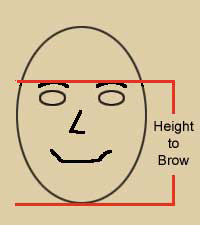
underside of chin to brow ridge
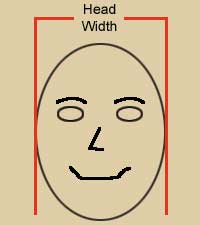
width of head
Payments for mask and other fencing gear:
I like PayPal. My account is my usual email address horsebows@gmail.com
Shipping a Mask by US Post Office Priority Mail inside USA is included in quoted price. Shipping out of USA will be determined at time of final payment. Packaged the mask weighs 3 kilo, 30x25x25 cm. For my fellow Americans that is 7 pounds and 12x10x10 inches.
When you have emailed me all the measurements and color choices I will put your order in the queue.
I have been making custom armor for 4 decades and have found I do not like holding the customers money. So please do not send down payment until I email you that your mask is a couple of weeks out. THEN I ask for half down. Shall email you when it is ready to ship - asking for the balance.
If you would prefer to send a check, that is fine, less money to the credit card companies. Remind me to send you a few spare screw rivets or rapier blunts.
Rapier tips / Rubber arrow blunts
These come in four diameters to match the diameter of arrow shafts.
They are also used in fencing to blunt the ends of fencing rapiers, schlagers, and daggers.
Available diameters:
- 1/4 inch blue
- 5/16 inch red
- 11/32 inch black
- 23/64 inch green
- Large HTM brand, they kinda look like a small crutch tip — These are the largest blunts a few rapiers do not fit in smaller, Also some two handed swords will fit in them. Many two handed swords need custom made leather ends.
For archery these are put on the unsharpened end of a wooden shaft. If used on aluminum or carbon shafts something is needed to fill the inside of the tubular shaft. If they are put on a sharpened wood or open end of a tubular shaft, the shaft will cut into, and eventually through the rubber.
For fencing some clubs require a metal washer or rawhide strip be put in to protect the rubber from the metal tip of the sword.
Any combination of blunt sizes are: $2 each, 6 for $10
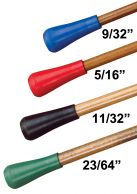
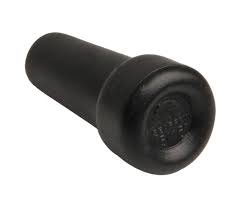
Bucklers
I manufacture steel bucklers. These are the simplest and most frequently pictured in paintings and manuals.
For rapier or small sword they are of 18-gauge steel and curved forward from the boss to catch sword points as pictured in the 17th century Bolognaise fencing manuals. 8 to 10 inches in diameter with steel handle. Price: $100
For broadsword — either steel or wooden — the bucklers are of 16-gauge steel and curled back to guide the cutting blows away. These are in many old paintings – for example hanging by the sword of English long bow men of the “100 years war”. I am attempting to reproduce the ones from the fighting manual that was written about 1325 in Germany and is called by its museum number "I-33" (Roman one, Arabic threes). Mine are 12 to 14 inches in diameter, a pronounced boss and then the rest slopes back at a lesser angle to guide the sword cut away. Not the one that looks like a straw hat.I make these in 16 ga. Price: $100
CAS Iberia offer these in 14ga. I find them too heavy for fencing and in my opinion over weight for broadsword.